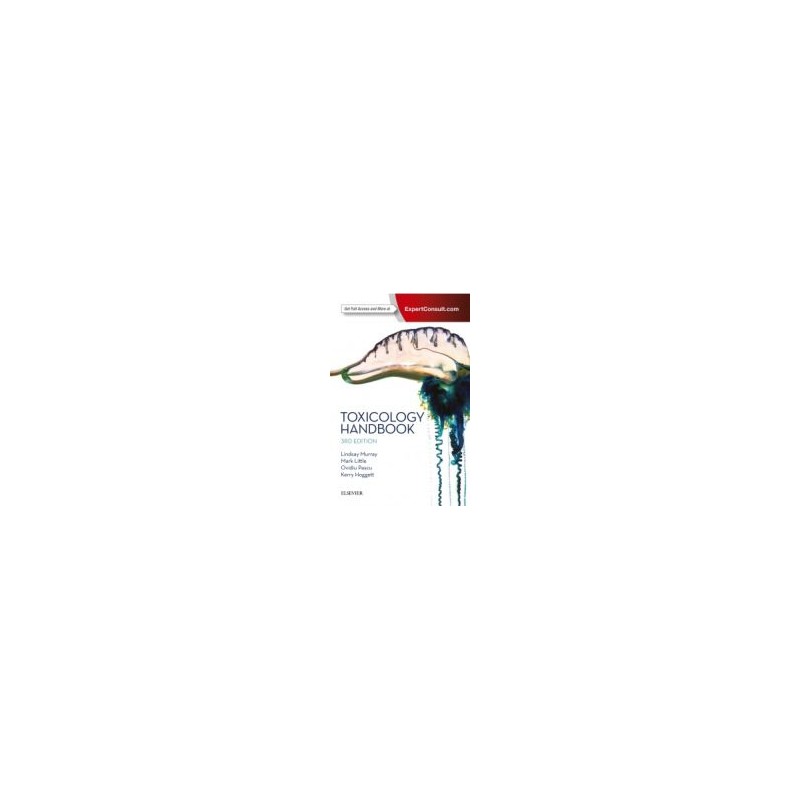- Obniżka


 Dostawa
Dostawa
Wybierz Paczkomat Inpost, Orlen Paczkę, DHL, DPD, Pocztę, email (dla ebooków). Kliknij po więcej
 Płatność
Płatność
Zapłać szybkim przelewem, kartą płatniczą lub za pobraniem. Kliknij po więcej szczegółów
 Zwroty
Zwroty
Jeżeli jesteś konsumentem możesz zwrócić towar w ciągu 14 dni*. Kliknij po więcej szczegółów
Toxicology Handbook is a practical evidence-based guide on the care of the poisoned patient.
This concise text is informed by the latest clinical research and takes a rigorous and structured risk assessment-based approach to decision making in the context of clinical toxicology.
It assists the clinician to quickly find information on poisons, toxins, antidotes, envenomings and antivenoms and determine the appropriate treatment for the acutely poisoned patient.
Opis
CHAPTER 1 APPROACH TO THE POISONED PATIENT 1.1 Overview 1.2 Resuscitation 1.3 Risk assessment 1.4 Supportive care and monitoring 1.5 Investigations 1.6 Gastrointestinal decontamination 1.7 Enhanced elimination 1.8 Antidotes 1.9 Disposition
CHAPTER 2 SPECIFIC CONSIDERATIONS 2.1 Approach to snakebite 2.2 Approach to mushroom poisoning 2.3 Approach to plant poisoning 2.4 Coma 2.5 Hypotension 2.6 Seizures 2.7 Delirium and agitation 2.8 Serotonin syndrome 2.9 Anticholinergic syndrome 2.10 Cholinergic syndrome 2.11 Neuroleptic malignant syndrome 2.12 Alcohol use disorder 2.13 Amphetamine use disorder 2.14 Opioid use disorder 2.15 Sedative-hypnotic use disorder 2.16 Solvent abuse 2.17 Body packers and stuffers 2.18 Osmolality and the osmolar gap 2.19 Acid - base disorders 2.20 The 12-lead ECG in toxicology 2.21 Poisoning during pregnancy and lactation 2.22 Poisoning in children 2.23 Poisoning in the elderly
CHAPTER 3 SPECIFIC TOXINS 3.1 Alcohol: Ethanol 3.2 Alcohol: Ethylene glycol 3.3 Alcohol: Isopropanol (isopropyl alcohol) 3.4 Alcohol: Methanol (methyl alcohol) 3.5 Alcohol: Other toxic alcohols 3.6 Amiodarone 3.7 Amisulpride 3.8 Amphetamines 3.9 Angiotensin converting enzyme inhibitors 3.10 Anticoagulant rodenticides 3.11 Anticonvulsants: Newer agents 3.12 Antihistamines (non-sedating) 3.13 Antihistamines (sedating) 3.14 Arsenic 3.15 Baclofen 3.16 Barbiturates 3.17 Benzodiazepines 3.18 Benztropine 3.19 Beta-blockers 3.20 Bupropion 3.21 Button batteries 3.22 Calcium channel blockers 3.23 Cannabinoids (marijuana) 3.24 Carbamazepine 3.25 Carbon monoxide 3.26 Chloroquine and hydroxychloroquine 3.27 Chloral hydrate 3.28 Clonidine 3.29 Clozapine 3.30 Cocaine 3.31 Colchicine 3.32 Corrosives 3.33 Cyanide 3.34 Digoxin: Acute overdose 3.35 Digoxin: Chronic poisoning 3.36 Diphenoxylate-atropine 3.37 Gamma-hydroxybutyrate (GHB) 3.38 Glyphosate 3.39 Hydrocarbons 3.40 Hydrofluoric acid 3.41 Hydrogen peroxide 3.42 Insulin 3.43 Iron 3.44 Isoniazid 3.45 Lead 3.46 Lithium: Acute overdose 3.47 Lithium: Chronic poisoning 3.48 Local anaesthetic agents 3.49 Mercury 3.50 Metformin 3.51 Methotrexate 3.52 Mirtazapine 3.53 Monoamine oxidase inhibitors (MAOIs) 3.54 Newer oral anticoagulants (NOACs) 3.55 Non-steroidal anti-inflammatory drugs (NSAIDs) 3.56 Olanzapine 3.57 Opioids 3.58 Organochlorines 3.59 Organophosphorus agents (organophosphates and carbamates) 3.60 Paracetamol: Acute overdose 3.61 Paracetamol: Modified-release formulations 3.62 Paracetamol: Repeated supratherapeutic ingestion 3.63 Paraquat 3.64 Phenothiazines and butyrophenones (antipsychotic agents) 3.65 Phenytoin 3.66 Potassium chloride 3.67 Quetiapine 3.68 Quinine 3.69 Risperidone 3.70 Salicylates 3.71 Selective serotonin reuptake inhibitors (SSRIs) 3.72 Strychnine 3.73 Sylfonyureas 3.74 Theophylline 3.75 Thyroxine 3.76 Tramadol 3.77 Tricyclic antidepressants (TCAs) 3.78 Valproic acid (sodium valproate) 3.79 Venlafaxine and desvenlafaxine 3.80 Warfarin
CHAPTER 4 ANTIDOTES 4.1 Atropine 4.2 Calcium 4.3 Cyproheptadine 4.4 Desferrioxamine 4.5 Dicobalt edetate 4.6 Digoxin immune Fab 4.7 Dimercaprol 4.8 Ethanol 4.9 Flumazenil 4.10 Folinic acid 4.11 Fomepizole 4.12 Glucose 4.13 Hydroxocobalamin 4.14 Insulin (high dose) 4.15 Intravenous lipid emulsion 4.16 Methylene blue 4.17 N-acetylcysteine 4.18 Naloxone 4.19 Octreotide 4.20 Penicillamine 4.21 Physostigmine 4.22 Pralidoxime 4.23 Pyridoxine 4.24 Sodium bicarbonate 4.25 Sodium calcium edetate 4.26 Sodium thiosulfate 4.27 Succimer 4.28 Vitamin K
CHAPTER 5 ENVENOMINGS 5.1 Black snake 5.2 Brown snake 5.3 Death adder 5.4 Tiger snake group 5.5 Taipan 5.6 Sea snake 5.7 Australian scorpions 5.8 Bluebottle jellyfish (Physalia species) 5.9 Stonefish 5.10 Box jellyfish (Chironex fleckeri) 5.11 Irukandji syndrome 5.12 Blue-ringed octopus 5.13 Redback spider 5.14 Funnel-web (big black) spider 5.15 White-tailed spider 5.16 Ticks
CHAPTER 6 ANTIVENOMS 6.1 CSL Black Snake Antivenom 6.2 CSL Brown Snake Antivenom 6.3 CSL Death Adder Antivenom 6.4 CSL Tiger Snake Antivenom 6.5 CSL Taipan Antivenom 6.6 CSL Sea Snake Antivenom 6.7 CSL Polyvalent Snake Antivenom 6.8 CSL Stonefish Antivenom 6.9 CSL Box Jellyfish Antivenom 6.10 CSL Redback Spider Antivenom 6.11 CSL Funnel-web Spider Antivenom
APPENDICES Appendix 1 Poison Information Telephone Numbers Appendix 2 Example ECGs Appendix 3 Conversion factors and therapeutic ranges for important toxins Appendix 4 Alcohol pathways Appendix 5 Therapeutic over-warfarinisation Appendix 6 Management of allergic reactions to antivenoms
